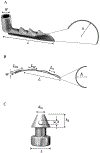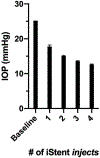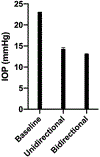Modeling the effects of glaucoma surgery on intraocular pressure
- PMID: 34048778
- PMCID: PMC8595518
- DOI: 10.1016/j.exer.2021.108620
Modeling the effects of glaucoma surgery on intraocular pressure
Abstract
Minimally invasive glaucoma surgeries (MIGS) offer an effective way to lower intraocular pressure without inducing extensive trauma to the anterior segment. In order to predict their efficacy, an analytical model of the conventional aqueous humor outflow pathway is developed using a resistor network. The model describes outflow through the normal eye and allows for the effects of geometric changes in the outflow pathway as IOP changes. By selectively removing these resistors, the model can be used to examine and predict the outcomes of several surgical procedures currently used to treat glaucoma. Treatments examined include traditional trabeculectomy, several ab interno methods for trabeculotomy and trabeculectomy, as well as recently developed trabecular stents that bypass the trabecular meshwork and dilate Schlemm canal. The model's predictions for the efficacy of these procedures generally matched well with the efficacy determined in experimental studies, although it tended to somewhat overestimate the efficacy of these procedures. Matching the model to experimental data indicated that a partial trabeculotomy substantially increases flow to collector channels within that region and approximately 1.5 clock hours past the ends of the trabeculotomized region. Similarly, trabecular bypass stents substantially increase flow to collector channels up to 1.5 clock hours past the open ends of the stent. The resistor model we have developed can be used to predict the efficacy of a variety of MIGS procedures. Circumferential flow in Schlemm canal extends the efficacy of MIGS, but this effect is limited to a few clock hours.
Keywords: MIGS; Model; Stents; Trabeculotomy.
Copyright © 2021 Elsevier Ltd. All rights reserved.
Figures












References
-
- Bahler CK, Hann CR, Fjield T, Haffner D, Heitzmann H, Fautsch MP, 2012. Second-generation Trabecular Meshwork Bypass Stent (iStent inject) Increases Outflow Facility in Cultured Human Anterior Segments. American Journal of Ophthalmology 153, 1206–1213. - PubMed
-
- Brubaker RF, 1975. The effect of intraocular pressure on conventional outflow resistance in the enucleated human eye. undefined. - PubMed
-
- de Kater AW, Melamed S, Epstein DL, 1989. Patterns of Aqueous Humor Outflow in Glaucomatous and Nonglaucomatous Human Eyes: A Tracer Study Using Cationized Ferritin. Archives of Ophthalmology 107, 572–576. - PubMed
Publication types
MeSH terms
Grants and funding
LinkOut - more resources
Full Text Sources
Other Literature Sources
Medical
Miscellaneous

